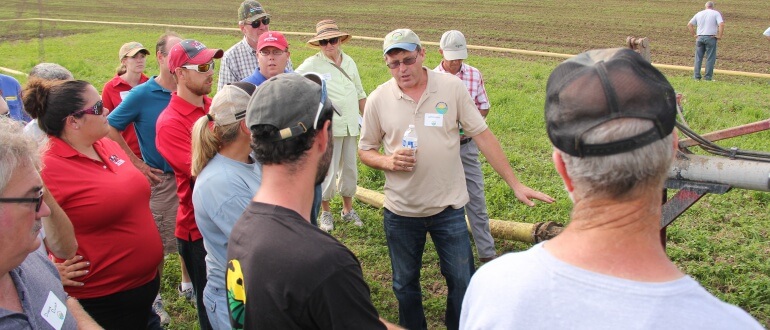Soil is a farmer’s best asset. It provides the nutrients for crops to grow and prosper. To enrich their soil, farmers use various conservation practices to ensure the vitality for generations to come. One such practice is utilizing cover crops, which are grown to improve the soil rather than for profit.
Jeff Endres, chair of Yahara Pride Farms, is doing his best to protect the soil on his farm. Endres planted a pea and barley mix in mid-August after he harvested his winter wheat this July. After he finishes harvesting his corn this fall, he will plant barley. He has found these cover crops to improve his soil and help with the future crop.
“We’ve been able to work cover crops into the rotation. With the establishment of the cover crops, we’re getting by with less tillage. Anytime you can reduce tillage, it helps with nutrients leaving the field,” said Endres.
In October, when Endres harvests his pea and barley mix, he will use the cover crop as a feed alternative. By adding peas into his rotation, he can increase the amount of protein in his feed.
Endres plants barley because it is a fast growing crop that provides him with the maximum amount of coverage. Barley does not winter, meaning the crop dies over the winter and does not require any herbicide application to kill the crop in the spring. Endres has also noticed barley suppresses wheat growth the following spring when he seeds alfalfa.
However, Endres has seen challenges in planting cover crops this fall with the inclement weather.
“We started getting all this rain and cover crop planting is behind schedule. There is a pretty good chance that cover crop acres might be down because it is getting too late for farmers to establish them,” explained Endres.
The considerable amount of rain has pushed back harvest and has created wet field conditions. Farmers are running out of time to plant their cover crops and get them established before winter comes.
“That’s Mother Nature at work. Mother Nature always gets the last word,” remarked Endres.
Cover crops are not the only way for farmers to replenish their soil. Rotating their crops every year helps replace nutrients back into the soil. Endres rotates between corn, wheat and alfalfa.
“Alfalfa is a legume and legumes put organic nitrogen back into the soil. It is really good to follow alfalfa with wheat or corn because those two plants are from the grass family and utilize a lot of nitrogen,” explained Endres.
When a farmer has a rotation, they can rotate and incorporate cover crops into their mix. This requires less tillage and provides the farmer with the benefit of crop rotations. Making it a win-win for the farmer and the soil.
“Farmers are doing their best to make everything work out here,” affirmed Endres.
To support conservation practices on farm acres in the Yahara watershed, donate to the Clean Lakes Alliance Conserve an Acre program. Just $50 can help cover costs to implement cover crops on one acre of farmland.
. . .
Mikayla Simonson is a native Badger from Taylor, Wis. She studies Life Sciences Communication with a certificate in Business Management for Agricultural & Life Sciences at the University of Wisconsin-Madison and will be graduating in December 2016. As Clean Lakes Alliance’s Marketing and Design Intern, Mikayla will assist in day-to- day activities, compose Forward Farmer articles and helping to promote the work of Clean Lakes Alliance. In her free time, Mikayla enjoys hiking at various State Parks, kayaking and running.




